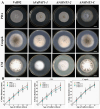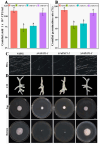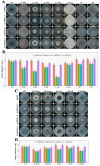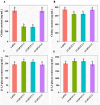VdPAT1 encoding a pantothenate transporter protein is required for fungal growth, mycelial penetration and pathogenicity of Verticillium dahliae
- PMID: 39895932
- PMCID: PMC11783681
- DOI: 10.3389/fmicb.2024.1508765
VdPAT1 encoding a pantothenate transporter protein is required for fungal growth, mycelial penetration and pathogenicity of Verticillium dahliae
Abstract
Introduction: The soil-borne vascular fungus Verticillium dahliae is a phytopathogenic fungus known to attack cotton crop causing Verticillium wilt. In previous study, we identified a pantothenate transporter gene (VdPAT1) in V. dahliae which can be induced by root exudates from a susceptible cotton variety.
Methods: In this study, we generated VdPAT1 deletion mutants and complementary strain via homologous recombination by a PEG-mediated transformation method and used for the gene functional characterization.
Results and discussion: The VdPAT1 deletion mutants displayed reduced colony growth, melanin production, spore yield and germination rate, showed abnormal mycelial branching and decreased ability of mycelial penetration and utilization of nutrients (carbon, amino acids and vitamin), leading to a lower pathogenicity. Comparative transcriptome analysis of wild-type and mutant strain cultivated on sterilized carboxymethyl cellophane membranes found that the amino sugar and nucleotide sugar metabolism pathway, which was related to chitin synthesis and degradation as well as UDP-glucose synthesis, was the most significantly down-regulated pathway in VdPAT1 deletion mutant. Chitin and β-1,3-glucan content determination found that the chitin content in VdPAT1 deletion mutants was significantly lower, while β-1,3-glucan content was higher than that of wild-type and complementary strains. The ratio change of chitin and β-1,3-glucan content in VdPAT1 deletion mutants might lead to abnormal branching of mycelium, resulting in the reduced penetration ability of V. dahliae. The decreased chitin content in VdPAT1 mutants impaired the fungal cell wall integrity, leading to their increased sensitivity to external stresses.
Conclusion: Together, the results demonstrated that VdPAT1 is required for growth, development, resistance to external stresses, mycelial penetration and pathogenicity of V. dahliae.
Keywords: RNA-Seq; Verticillium dahliae; cotton; mycelial penetration; pantothenate transporter.
Copyright © 2025 Kamau, Li, Sun, Liu, Zhu, Zhang, Sun and Li.
Conflict of interest statement
The authors declare that the research was conducted in the absence of any commercial or financial relationships that could be construed as a potential conflict of interest. The author(s) declared that they were an editorial board member of Frontiers, at the time of submission. This had no impact on the peer review process and the final decision.
Figures










Similar articles
-
VdPT1 Encoding a Neutral Trehalase of Verticillium dahliae Is Required for Growth and Virulence of the Pathogen.Int J Mol Sci. 2023 Dec 25;25(1):294. doi: 10.3390/ijms25010294. Int J Mol Sci. 2023. PMID: 38203466 Free PMC article.
-
Identification and Functional Analysis of a Novel Hydrophobic Protein VdHP1 from Verticillium dahliae.Microbiol Spectr. 2022 Apr 27;10(2):e0247821. doi: 10.1128/spectrum.02478-21. Epub 2022 Apr 4. Microbiol Spectr. 2022. PMID: 35377232 Free PMC article.
-
VdP5CDH is involved in melanin formation, stress resistance and play a regulatory role in virulence of Verticillium dahliae.Front Microbiol. 2024 Jul 24;15:1429755. doi: 10.3389/fmicb.2024.1429755. eCollection 2024. Front Microbiol. 2024. PMID: 39113834 Free PMC article.
-
Identification of sugar transporter genes and their roles in the pathogenicity of Verticillium dahliae on cotton.Front Plant Sci. 2023 Jan 26;14:1123523. doi: 10.3389/fpls.2023.1123523. eCollection 2023. Front Plant Sci. 2023. PMID: 36778686 Free PMC article.
-
Interactions between Verticillium dahliae and cotton: pathogenic mechanism and cotton resistance mechanism to Verticillium wilt.Front Plant Sci. 2023 Apr 21;14:1174281. doi: 10.3389/fpls.2023.1174281. eCollection 2023. Front Plant Sci. 2023. PMID: 37152175 Free PMC article. Review.
References
-
- Albuquerque C. C., Camara T. R., Mariano R. L. R., Willadino L., Marcelino J. C., Ulisses C. (2006). Antimicrobial action of the essential oil of Lippia gracilis schauer. Braz. Arch. Biol. Technol. 49, 527–535. doi: 10.1590/S1516-89132006000500001 - DOI
-
- Badaruddin M., Holcombe L. J., Wilson R. A., Wang Z. Y., Kershaw M. J., Talbot N. J. (2013). Glycogen metabolic genes are involved in trehalose-6-phosphate synthase-mediated regulation of pathogenicity by the rice blast fungus Magnaporthe oryzae. PLoS Pathog. 9:e1003604. doi: 10.1371/journal.ppat.1003604, PMID: - DOI - PMC - PubMed
-
- Bagchi S., Perland E., Hosseini K., Lundgren J., Al-Walai N., Kheder S., et al. . (2020). Probable role for major facilitator superfamily domain containing 6 (MFSD6) in the brain during variable energy consumption. Int. J. Neurosci. 130, 476–489. doi: 10.1080/00207454.2019.1694020, PMID: - DOI - PubMed
-
- Benjamini Y., Hochberg Y. (1995). Controlling the false discovery rate: a practical and powerful approach to multiple testing. J. R. Stat. Soc. B 57, 289–300. doi: 10.1111/j.2517-6161.1995.tb02031.x - DOI
LinkOut - more resources
Full Text Sources

